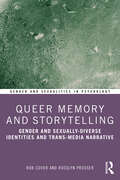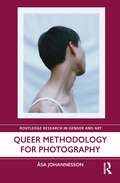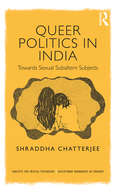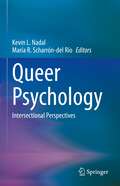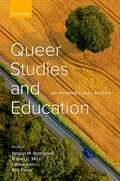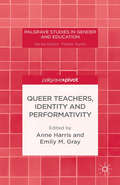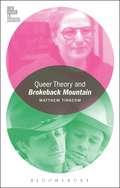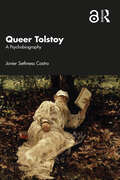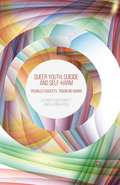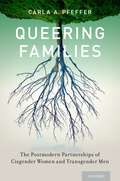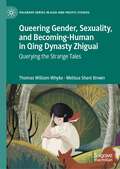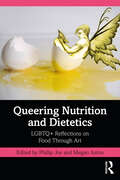- Table View
- List View
Queer Memory and Storytelling: Gender and Sexually-Diverse Identities and Trans-Media Narrative (Gender and Sexualities in Psychology)
by Rob Cover Rosslyn ProsserQueer Memory and Storytelling unpacks the ways in which the narrative practices of recounting past experiences play a formative role in formation of identities, cultures, and social change among gender and sexually diverse individuals.Grounded in theoretical research, this work delves into historical accounts, case studies, and draws from the rich tapestry of interviews conducted during extensive LGBTQ+ research studies. It explores the power of memorial storytelling to shape the narratives surrounding gender and sexual diversity, offering profound insights into the role storytelling plays as a deeply subjective, personal, communal, and cultural form of expression. The book introduces a queer perspective that reframes the study of narrative psychology, community history, philosophies of subjectivity and the socio-cultural heritage of LGBTQ+ minority communities. It also focuses on the pivotal role played by memory and reflection found within online coming-up stories and contemporary modes of shared community memorialization. By employing queer theory, ethnographic research, interviews and meticulous media/textual analysis, the book presents new frameworks for comprehending the myriad facets of identity, and investigating what it means to remember and narrate selfhood in the context of social life, actively ‘queering’ the concept of memory.Queer Memory and Storytelling will appeal to academics, researchers and students in psychology, sociology, gender and sexuality studies, and communication.
The Queer Mental Health Workbook: A Creative Self-Help Guide Using CBT, CFT and DBT
by Dr. Brendan Dunlop'A privilege to read, a pleasure to endorse' PROFESSOR TANYA BYRON'This book completely bowled me over' DOMINIC DAVIES'A super comprehensive book' MEG-JOHN BARKERTo be queer is to feel different - a felt sense that you don't fit in. This can be alienating and difficult and lead to mental health challenges and lower wellbeing throughout life. Using a range of therapeutic approaches, this comprehensive, down-to-earth self-help workbook is designed to be your personal mental health resource. It is filled with techniques and activities you can read, tailor and 'pick and mix' to improve your wellbeing as a queer person, at your pace.The workbook is split into two sections - the first part focusses on laying the groundwork by exploring identity, psychological wellbeing, and mental health experiences in order to situate mental health challenges in context and improve overall mental health. The second half hones in on ideas and techniques applicable to specific challenges and situations. It explores difficult topics such as anxiety, low self-esteem, eating disorders, self-harm, suicidal ideation, shame, trauma, substance abuse, sleep, and low mood, all whilst maintaining a focus on your needs as a queer individual.Empowering and reassuring, and written by an experienced queer mental health practitioner, this one-of-a-kind workbook will help you to flourish as a queer person and begin to overcome any challenge.
Queer Methodology for Photography (Routledge Research in Gender and Art)
by Asa JohannessonThis book presents new ways of approaching photographic discourse from a queer perspective, offering discussions on what a queering methodology for photography may entail by drawing links between artistic strategies in photographic practice and key theoretical concepts from photography theory, queer theory, critical theory, and philosophy. With different examples of conceptual perspectives, including representation, formalism, and mediumlessness, it seeks to diversify queer methodology for photography. While primarily addressing photography, this book is entwined with broader philosophical questions concerning identity, difference, and the creations of systems of thought that limit the possibilities of existence to binary categorisation. It proposes a new concept of the photographic image that addresses its materiality, in the form of the poetic and the political, in relationship to a generative principle that is named as a queer quality: the photograph’s ability to voice queer concerns also beyond its role as representation. This book will be of interest to scholars working in photography, art history, queer studies, new materialism, and posthumanism.
Queer Methodology for Photography (Routledge Research in Gender and Art)
by Asa JohannessonThis book presents new ways of approaching photographic discourse from a queer perspective, offering discussions on what a queering methodology for photography may entail by drawing links between artistic strategies in photographic practice and key theoretical concepts from photography theory, queer theory, critical theory, and philosophy. With different examples of conceptual perspectives, including representation, formalism, and mediumlessness, it seeks to diversify queer methodology for photography. While primarily addressing photography, this book is entwined with broader philosophical questions concerning identity, difference, and the creations of systems of thought that limit the possibilities of existence to binary categorisation. It proposes a new concept of the photographic image that addresses its materiality, in the form of the poetic and the political, in relationship to a generative principle that is named as a queer quality: the photograph’s ability to voice queer concerns also beyond its role as representation. This book will be of interest to scholars working in photography, art history, queer studies, new materialism, and posthumanism.
Queer Politics in India: Towards Sexual Subaltern Subjects (Concepts for Critical Psychology)
by Shraddha ChatterjeeQueer Politics in India simultaneously tells two interconnected stories. The first explores the struggle against violence and marginalization by queer people in the Indian subcontinent, and places this movement towards equality and inclusion in relation to queer movements across the world. The second story, about a lesbian suicide in a small village in India, interrupts the first one, and together, these two stories push and pull the book to elucidate the failure and promise of queer politics, in India and the rest of the world. This book emerges at a critical time for queer politics and activism in India, exploring the contemporary queer subject through the different lenses of critical psychology, Lacanian psychoanalysis, feminist and queer theory, and cultural studies in its critique of the constructions of discourses of ‘normal’ sexuality. It also examines how power determines further segregations of ‘abnormal’ sexuality into legitimate and illegitimate queer subjectivities and authentic and inauthentic queer experiences. By allowing a multifaceted and engaged critique to emerge that demonstrates how the idea of a universal queer subject fails lower class, lower caste queer subjects, and queer people of colour, the author expertly highlights how all queer people are not the same, even within queer movements, as the book asks the questions, "which queer subject does queer politics fight for?", and, "what is the imagination of a queer subject in queer politics?" This hugely important and timely work is relevant across many disciplines, and will be useful for students of psychology and other academic areas, as well as researchers and activist organizations.
Queer Politics in India: Towards Sexual Subaltern Subjects (Concepts for Critical Psychology)
by Shraddha ChatterjeeQueer Politics in India simultaneously tells two interconnected stories. The first explores the struggle against violence and marginalization by queer people in the Indian subcontinent, and places this movement towards equality and inclusion in relation to queer movements across the world. The second story, about a lesbian suicide in a small village in India, interrupts the first one, and together, these two stories push and pull the book to elucidate the failure and promise of queer politics, in India and the rest of the world. This book emerges at a critical time for queer politics and activism in India, exploring the contemporary queer subject through the different lenses of critical psychology, Lacanian psychoanalysis, feminist and queer theory, and cultural studies in its critique of the constructions of discourses of ‘normal’ sexuality. It also examines how power determines further segregations of ‘abnormal’ sexuality into legitimate and illegitimate queer subjectivities and authentic and inauthentic queer experiences. By allowing a multifaceted and engaged critique to emerge that demonstrates how the idea of a universal queer subject fails lower class, lower caste queer subjects, and queer people of colour, the author expertly highlights how all queer people are not the same, even within queer movements, as the book asks the questions, "which queer subject does queer politics fight for?", and, "what is the imagination of a queer subject in queer politics?" This hugely important and timely work is relevant across many disciplines, and will be useful for students of psychology and other academic areas, as well as researchers and activist organizations.
Queer Psychology: Intersectional Perspectives
by Kevin L. Nadal María R. Scharrón-del RíoQueer Psychology is the first comprehensive book to examine the current state of LGBTQ communities and psychology, through the lenses of both queer theory and Intersectionality theory. Thus, the book describes the experiences of LGBTQ people broadly, while also highlighting the voices of LGBTQ people of color, transgender and gender nonconforming people, those of religious minority groups, immigrants, people with disabilities, and other historically marginalized groups. Each chapter will include an intersectional case example, as well as implications for policy and practice.This book is especially important as there has been an increase in psychology and counseling courses focusing on LGBTQ communities; however, students often learn about LGBTQ-related issues through a White cisgender male normative perspective. The edited volume contains the contributions of leading scholars in LGBTQ psychology, and covers a number of concepts – ranging from identity development to discrimination to health.
Queer Studies and Education: An International Reader
by Nelson M. Rodriguez, Robert C. Mizzi, Louisa AllenQueer Studies and Education: An International Reader explores how the category queer, as a critical stance or set of perspectives, contributes to opportunities individually and collectively for advancing (queer) social justice within the context and concerns of schooling and education. The collection takes up this general goal by presenting a cross-section of international perspectives on queer studies in education to demonstrate commonalities, differences, uncertainties, or pluralities across a diverse range of national contexts and topics, drawing a heightened awareness of heterodominance and heteropatriarchy, and to conceptualize non-normative and non-essentialist imaginings for more inclusive educational environments. Collectively, the chapters critically engage with heteronormativity and normativity more generally as a political spectrum, over a broad range of formal and informal sites of education, and against a backdrop of critiques of liberalism and neoliberalism as the frameworks through which "achievable" social change and belonging are fostered, particularly within educational settings. Taken together, the chapters assembled in Queer Studies and Education invite researchers, scholars, educators, activists, and other cultural workers to examine the multiplicity of contemporary (international) work in queer studies and education with readers' interpretations of queer's deployment across the chapters forming the compass for which to arrive at fresh insights and forms of (queer) critical praxis.
Queer Studies and Education: An International Reader
Queer Studies and Education: An International Reader explores how the category queer, as a critical stance or set of perspectives, contributes to opportunities individually and collectively for advancing queer social justice within the context and concerns of schooling and education. The collection takes up this general goal by presenting a cross-section of international perspectives on queer studies in education to demonstrate commonalities, differences, uncertainties, or pluralities across a diverse range of national contexts and topics, drawing a heightened awareness of heterodominance and heteropatriarchy, and to conceptualize non-normative and non-essentialist imaginings for more inclusive educational environments. Collectively, the chapters critically engage with heteronormativity and normativity more generally as a political spectrum, over a broad range of formal and informal sites of education, and against a backdrop of critiques of liberalism and neoliberalism as the frameworks through which "achievable" social change and belonging are fostered, particularly within educational settings. Taken together, the chapters assembled in Queer Studies and Education invite researchers, scholars, educators, activists, and other cultural workers to examine the multiplicity of contemporary (international) work in queer studies and education with readers' interpretations of queer's deployment across the chapters forming the compass for which to arrive at fresh insights and forms of queer critical praxis.
Queer Teachers, Identity and Performativity (Palgrave Studies in Gender and Education)
by Anne Harris Emily M. GrayWhat do we mean when we talk about 'queer teachers'? The authors here grapple with what it means to be sexually or gender diverse and to work as a school teacher within four national contexts: Australia, Ireland, the UK and the USA. This new volume offers academics, educators and students a provocative exploration of this pivotal topic.
Queer Theory and Brokeback Mountain (Film Theory in Practice)
by Matthew TinkcomQueer Theory and Brokeback Mountain examines queer theory as it has emerged in the past three decades and discusses how Brokeback Mountain can be understood through the terms of this field of scholarship and activism. Organized into two parts, in the first half the author discusses key canonical texts within queer theory, including the work of writers as Judith Butler, Michel Foucault, and Eve Kosofsky Sedgwick. He provides an historical account of the questions these scholars have posed to our understanding of sexualities-both normative and non-normative-in the historical past and in contemporary life, as well as a discussion of the theories of sexuality and gender offered by these scholars as these phenomena shape the experiences of men and women in the genital, bodily, erotic, discursive, and cultural dimensions.The second part examines Ang Lee's 2005 feature film, Brokeback Mountain, in order to understand the claims and insights of queer theory. Tracing the film's adaptation by screenwriter Larry McMurtry of Annie Proulx's 1997 short story of the same title, this portion of the book examines the film's narrative about two working-class men in the rural mid-20th-century U.S. and the meanings of the sexual and emotional bond between the pair that develops over the course of two decades.
Queer Theory and Brokeback Mountain (Film Theory in Practice)
by Matthew TinkcomQueer Theory and Brokeback Mountain examines queer theory as it has emerged in the past three decades and discusses how Brokeback Mountain can be understood through the terms of this field of scholarship and activism. Organized into two parts, in the first half the author discusses key canonical texts within queer theory, including the work of writers as Judith Butler, Michel Foucault, and Eve Kosofsky Sedgwick. He provides an historical account of the questions these scholars have posed to our understanding of sexualities-both normative and non-normative-in the historical past and in contemporary life, as well as a discussion of the theories of sexuality and gender offered by these scholars as these phenomena shape the experiences of men and women in the genital, bodily, erotic, discursive, and cultural dimensions.The second part examines Ang Lee's 2005 feature film, Brokeback Mountain, in order to understand the claims and insights of queer theory. Tracing the film's adaptation by screenwriter Larry McMurtry of Annie Proulx's 1997 short story of the same title, this portion of the book examines the film's narrative about two working-class men in the rural mid-20th-century U.S. and the meanings of the sexual and emotional bond between the pair that develops over the course of two decades.
Queer Tolstoy: A Psychobiography
by Javier Sethness CastroQueer Tolstoy is a multidimensional work combining psychoanalysis, political history, LGBTQ+ studies, sexology, ethics, and theology to explore the life and art of Count Lev Nikolaevich Tolstoy. Using a psychobiographical framework, Sethness Castro uncovers profoundly queer dimensions in Tolstoy’s life experiences and art. Deftly contributing to the progressive and radical analysis of gender and sexuality, this book examines how Tolstoy’s erotic dissidence informed his anarchist politics, anti-militarist ideals, and voluminous literary production. Sethness Castro analyzes the influence of Buddha, Socrates, Jesus, Cervantes, Rousseau, Kant, Herzen, Proudhon, Chernyshevsky, and his mother Marya Volkonskaya on the artist's writings. Furthermore, he details Tolstoy's emblematic linking of LGBTQ+ desire with moral and erotic self-determination and resistance to Tsarist despotism—especially in War and Peace. This book is vital reading for those interested in the intersection of literature, psychoanalysis, queer studies, and Russian history.
Queer Tolstoy: A Psychobiography
by Javier Sethness CastroQueer Tolstoy is a multidimensional work combining psychoanalysis, political history, LGBTQ+ studies, sexology, ethics, and theology to explore the life and art of Count Lev Nikolaevich Tolstoy. Using a psychobiographical framework, Sethness Castro uncovers profoundly queer dimensions in Tolstoy’s life experiences and art. Deftly contributing to the progressive and radical analysis of gender and sexuality, this book examines how Tolstoy’s erotic dissidence informed his anarchist politics, anti-militarist ideals, and voluminous literary production. Sethness Castro analyzes the influence of Buddha, Socrates, Jesus, Cervantes, Rousseau, Kant, Herzen, Proudhon, Chernyshevsky, and his mother Marya Volkonskaya on the artist's writings. Furthermore, he details Tolstoy's emblematic linking of LGBTQ+ desire with moral and erotic self-determination and resistance to Tsarist despotism—especially in War and Peace. This book is vital reading for those interested in the intersection of literature, psychoanalysis, queer studies, and Russian history.
Queer Voices in the Works of Richard von Krafft-Ebing, 1883–1901 (Genders and Sexualities in History)
by Douglas PretsellThis book is a critical edition of the autobiographical case studies used by the Austro-German psychiatrist Richard von Krafft-Ebing between 1883 and 1901. Forty-one individual case studies of same-sex attracted men and women, in their own words, made an eye-catching component of Krafft-Ebing’s most important work, PsychopathiaSexualis. Although the psychiatrist probably edited the autobiographical case studies, with the racier passages rendered in rather rudimentary Latin, what is particularly remarkable is that he preserved an unmistakeable queer discourse in some of the case studies that disputed the pathologising ideologies of the psychiatric texts in which they were embedded. Most of the autobiographies of same-sex attracted men follow the discursive patterns established in nineteenth-century psychiatry in providing descriptions of body features including genital size and shape, mental and physical health, family histories of health and disease, and accounts of life events from childhood to the present. This was because these men had been following Krafft-Ebing’s works and were now using their autobiographical contributions in Psychopathia Sexualis as a platform for negotiating the parameters of sexual orientation. Women’s sexuality was a relatively undeveloped component of Krafft-Ebing’s sexology but there are four case studies of women containing autobiographical content. Similarly, gender variance was hardly differentiated from sexuality at this period, but there are three autobiographies that clearly articulate cross gender identification, anticipating the future categories of transsexual and transgender. Krafft-Ebing reserved his therapeutic interventions to those individuals attracted to both sexes where hypnosis could supress same sex urges. Seven of these individuals supplied sexual autobiographies with two of them undergoing treatment as part of the overall case study. Together, these forty-one accounts give the reader a window into queer self-conceptions in Austria and Germany as the nineteenth century drew to a close.
Queer Youth, Suicide and Self-Harm: Troubled Subjects, Troubling Norms
by E. McDermott K. RoenOffering a new way of understanding the high self-harm and suicide rates among sexual and gender minority youth, this book prioritises the perspectives and experiences of queer young people, including those who have experience of self-harming and/or feeling suicidal. Presenting analysis based on research carried out with young people both online and face-to-face, the authors offer a critical perspective on the role of norms, namely developmental norms, gender and sexuality norms, and neoliberal norms, in the production of self-harming and suicidal youth. Queer Youth, Suicide and Self-Harm is unique in the way it works at the intersection of class and sexuality, and in its specific focus on transgender youth and the concept of embodied distress. It also examines the implications of this research for self-harm reduction and suicide prevention.
Queering Critical Literacy and Numeracy for Social Justice: Navigating the Course (Queer Studies and Education)
by Summer Melody PennellThis volume explores the value of using queer pedagogy in an interdisciplinary middle school classroom to promote a better understanding of social justice and the social construction of knowledge among students. In the course of the study, which combined student-centered literacy and mathematical inquiries through a social justice lens, students used critical literacy skills to research social justice topics, learned to read numerical data like traditional print text, and created and solved their own math problems. In bringing together critical mathematics and critical literacy through a queer lens, the author offers new ways of thinking that challenges norms and helps students embrace new concepts of learning for the modern era.
Queering Families: The Postmodern Partnerships of Cisgender Women and Transgender Men (Sexuality, Identity, and Society)
by Carla A. PfefferOzzie and Harriet, move over. A new couple is moving into the neighborhood. In the postmodern era, advances in medical technologies allow some individuals categorized female at birth to live in accordance with their gender identities, as men. While a growing body of literature on transgender men's experiences has come to the forefront, relatively little exists to document the experiences of their partners. In Queering Families: The Postmodern Partnerships of Cisgender Women and Transgender Men, Carla A. Pfeffer brings these experiences to light through interviews with the group most likely to partner and form families with transgender men: non-transgender (cisgender) women. Drawing upon in-depth interviews with fifty cisgender women partners of transgender men from across the United States and Canada, Pfeffer details the experiences of a community that often seems unremarkable and ordinary on its surface. Cisgender women who partner with transgender men who are socially "read" as male are often (mis)perceived as part of a heterosexual couple or family. Yet not all cisgender women who partner with transgender men are comfortable with this invisible existence and comfortable normativity. Instead, many of the cisgender women Pfeffer interviews hold deeply-valued queer identities that may be erased in their partnerships with transgender men. Queering Families details the struggles and strengths of these postmodern "Harriets" as they work to build identities, partnerships, families, and communities. Pfeffer's interviewees discuss the implications of visibility and invisibilty in their everyday lives as they face barriers or pathways to legal and social inclusion. They carve out new lexicons for partners' bodies and their own sexualities, transformed through gender-affirming hormones and surgeries. They plan and construct families with and without children, some drawing upon alternative reproductive technologies to bear the biological offspring of their transgender partners. With remarkable depth and insight, Queering Families explores a shifting social landscape that challenges the very notion of what constitutes a "same-sex" or an "opposite-sex" relationship, marriage, or family.
Queering Families: The Postmodern Partnerships of Cisgender Women and Transgender Men (Sexuality, Identity, and Society)
by Carla A. PfefferOzzie and Harriet, move over. A new couple is moving into the neighborhood. In the postmodern era, advances in medical technologies allow some individuals categorized female at birth to live in accordance with their gender identities, as men. While a growing body of literature on transgender men's experiences has come to the forefront, relatively little exists to document the experiences of their partners. In Queering Families: The Postmodern Partnerships of Cisgender Women and Transgender Men, Carla A. Pfeffer brings these experiences to light through interviews with the group most likely to partner and form families with transgender men: non-transgender (cisgender) women. Drawing upon in-depth interviews with fifty cisgender women partners of transgender men from across the United States and Canada, Pfeffer details the experiences of a community that often seems unremarkable and ordinary on its surface. Cisgender women who partner with transgender men who are socially "read" as male are often (mis)perceived as part of a heterosexual couple or family. Yet not all cisgender women who partner with transgender men are comfortable with this invisible existence and comfortable normativity. Instead, many of the cisgender women Pfeffer interviews hold deeply-valued queer identities that may be erased in their partnerships with transgender men. Queering Families details the struggles and strengths of these postmodern "Harriets" as they work to build identities, partnerships, families, and communities. Pfeffer's interviewees discuss the implications of visibility and invisibilty in their everyday lives as they face barriers or pathways to legal and social inclusion. They carve out new lexicons for partners' bodies and their own sexualities, transformed through gender-affirming hormones and surgeries. They plan and construct families with and without children, some drawing upon alternative reproductive technologies to bear the biological offspring of their transgender partners. With remarkable depth and insight, Queering Families explores a shifting social landscape that challenges the very notion of what constitutes a "same-sex" or an "opposite-sex" relationship, marriage, or family.
Queering Fat Embodiment (Queer Interventions)
by Samantha Murray Cat Pausé Jackie WykesCultural anxieties about fatness and the attendant stigmatisation of fat bodies, have lent a medical authority and cultural legitimacy to what can be described as ’fat-phobia’. Against the backdrop of the ever-growing medicalisation, pathologisation, and commodification of fatness, coupled with the moral panic over an alleged ’obesity epidemic’, this volume brings together the latest scholarship from various critical disciplines to challenge existing ideas of fat and fat embodiment. Shedding light on the ways in which fat embodiment is lived, experienced, regulated and (re)produced across a range of cultural sites and contexts, Queering Fat Embodiment destabilises established ideas about fat bodies, making explicit the intersectionality of fat identities and thereby countering the assertion that fat studies has in recent years reproduced a white, ableist, heteronormative subjectivity in its analyses. A critical queer examination on fatness, Queering Fat Embodiment will be of interest to scholars of cultural and queer theory, sociology and media studies, working on questions of embodiment, stigmatisation and gender and sexuality.
Queering Fat Embodiment (Queer Interventions)
by Samantha Murray Cat Pausé Jackie WykesCultural anxieties about fatness and the attendant stigmatisation of fat bodies, have lent a medical authority and cultural legitimacy to what can be described as ’fat-phobia’. Against the backdrop of the ever-growing medicalisation, pathologisation, and commodification of fatness, coupled with the moral panic over an alleged ’obesity epidemic’, this volume brings together the latest scholarship from various critical disciplines to challenge existing ideas of fat and fat embodiment. Shedding light on the ways in which fat embodiment is lived, experienced, regulated and (re)produced across a range of cultural sites and contexts, Queering Fat Embodiment destabilises established ideas about fat bodies, making explicit the intersectionality of fat identities and thereby countering the assertion that fat studies has in recent years reproduced a white, ableist, heteronormative subjectivity in its analyses. A critical queer examination on fatness, Queering Fat Embodiment will be of interest to scholars of cultural and queer theory, sociology and media studies, working on questions of embodiment, stigmatisation and gender and sexuality.
Queering Gender, Sexuality, and Becoming-Human in Qing Dynasty Zhiguai: Querying the Strange Tales (Palgrave Series in Asia and Pacific Studies)
by Thomas William Whyke Melissa Shani BrownThis book offers queer readings of Chinese Qing Dynasty zhiguai, ‘strange tales’, a genre featuring supernatural characters and events. In a unique approach interweaving Chinese philosophies alongside critical theories, this book explores tales which speak to contemporary debates around identity and power. Depictions of porous boundaries between humans and animals, transformations between genders, diverse sexualities, and contextually unusual masculinities and femininities, lend such tales to queer readings. Unlike previous scholarship on characters as allegorical figures or stories as morality tales, this book draws on queer theory, animal studies, feminism, and Deleuzian philosophy, to explore the ‘strange’ and its potential for social critique. Examining such tales enriches the scope of historic queer world literatures, offering culturally situated stories of relationships, desires, and ways of being, that both speak to and challenge contemporary debates.
Queering Gestalt Therapy: An Anthology on Gender, Sex & Relationship Diversity in Psychotherapy
by Ayhan Alman John Gillespie Vikram KolmannskogThe first peer-reviewed book of its kind, this important volume addresses a current gap in the field of gestalt therapy: that the practice—and psychotherapy more broadly—still suffers from pervasive hetero- and cis-normativity. This book offers gestalt-therapy-based research and training material on gender, sex, and relationship diversity (GSRD), including chapters on a variety of GSRD issues and how therapists can become more GSRD-sensitive. The contributors position themselves across the whole spectrum of GSRD and offer their voices as an invitation to further queer the gestalt community with diverse content ranging from academic, research-oriented pieces to experiential, reflective perspectives. Featured chapters explore topics including gender-radical clients, sex and sexuality, relationship diversity, integrating GSRD and gestalt therapy, and addressing heteronormativity in gestalt therapy training. Queering Gestalt Therapy is for everyone who is interested in gender, sex, and relationship diversity, especially as they relate to gestalt therapy practice. This book will be especially useful for therapists, supervisors, coaches, and students of gestalt therapy.
Queering Gestalt Therapy: An Anthology on Gender, Sex & Relationship Diversity in Psychotherapy
The first peer-reviewed book of its kind, this important volume addresses a current gap in the field of gestalt therapy: that the practice—and psychotherapy more broadly—still suffers from pervasive hetero- and cis-normativity. This book offers gestalt-therapy-based research and training material on gender, sex, and relationship diversity (GSRD), including chapters on a variety of GSRD issues and how therapists can become more GSRD-sensitive. The contributors position themselves across the whole spectrum of GSRD and offer their voices as an invitation to further queer the gestalt community with diverse content ranging from academic, research-oriented pieces to experiential, reflective perspectives. Featured chapters explore topics including gender-radical clients, sex and sexuality, relationship diversity, integrating GSRD and gestalt therapy, and addressing heteronormativity in gestalt therapy training. Queering Gestalt Therapy is for everyone who is interested in gender, sex, and relationship diversity, especially as they relate to gestalt therapy practice. This book will be especially useful for therapists, supervisors, coaches, and students of gestalt therapy.
Queering Nutrition and Dietetics: LGBTQ+ Reflections on Food Through Art
by Phillip Joy Megan AstonThis book presents experiences of LGBTQ+ people relating to food, bodies, nutrition, health, wellbeing, and being queer through critical writing and creative art. The chapters bring LGBTQ+ voices into the spotlight through arts-based scholarship and contribute to experiential learning, allowing for more understanding of the lives of LGBTQ+ people within the dietetic profession. Divided into three parts, the first explores eating, food, and bodies; the second discusses communities, connections, and celebrations; and the final part covers care in practice. Topics include body image, eating disorders, weight stigma, cooking and culinary journeys, queer food culture, queer practices in nutrition counseling, and gendered understandings of nutrition. Exploring not only experiences of marginalization, homophobia, transphobia, and cisheteronormativity within dietetics and nutritional healthcare, this collection also dives into the positive connections and supportive communities that food can create. Special attention is paid to the intersections of oppression, colonialism, social justice, and politics. This book will be beneficial to all health professionals, educators, and students creating and fostering safer, more inclusive, and more accepting environments for their LGBTQ+ clients.
